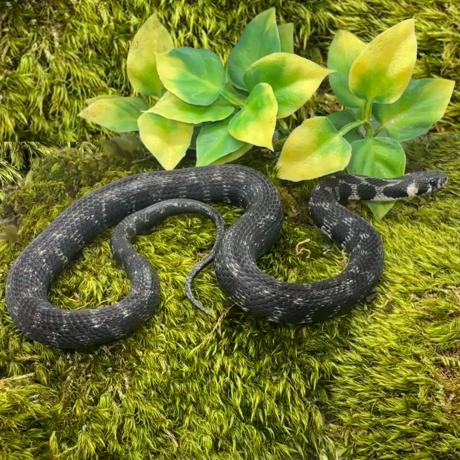

Milos Island Grass Snakes are similar in looks to the UK grass snake with the characteristic collar around the base of the neck with a black head. This species is endemic to Milos Island in Greece.
Milos Island Grass Snakes display the characteristic grass snake collar around the base of the neck with a black head. They have variable markings with an erratic pattern of black blotches down the length of their body, with a base colour ranging from light to dark olive-grey-brown and even black, with the belly scales being paler in colour. Their markings are most vibrant as hatchlings.
Males of this species can grow to an average length of up to 70cm but females can occasionally reach up to 100cm and have a wider girth.
They are endemic to Milos Island in Greece, where they are classified as endangered. Their scientific name natrix is said to derive from the word ‘natare’ which means ‘swim’; unsurprisingly they prefer habitats near to bodies of fresh water where they can easily find prey.
The main thing to consider when choosing enclosures for this species is ensuring the snake cannot escape, they are slender and fast so care must be taken during tank maintenance. Glass terrariums are best, as this species has higher humidity requirements, meaning that wooden vivariums tend to rot quite quickly. Young Milos Island Grass Snakes can be housed in slightly smaller glass enclosures 24x18” (LxW), but sub and fully-grown adults thrive in a 36x18x18” (minimum) terrarium or Paludarium.
You will need to provide your Milos Island Grass Snake with an average basking temperature of 30C (85F) during the day with a drop down to 25C (75F) at night. Temperatures can easily be maintained by using either a basking lamp or halogen lamp in a dome outside the terrarium; a suitable thermostat should control all heat sources to avoid risk of over or under heating. We suggest searching the average temperatures in their natural habitat and replicating the average throughout the year.
Research shows that UVB exposure contributes to healthy animals, both mentally and physically. We advise the use of UVB lighting within the parameters of Ferguson Zone 2 for your Milos Island Grass Snake. This species is diurnal (active during the day) and even when they appear to be hiding, many snakes will cryptically bask by leaving a part of their body exposed to the sunlight. The lighting is recommended to be on for 12 hours during the day and switched off at night to allow for a natural night time light and temperature drop.
This species will readily use a large water dish, or if space allows, a large paludarium with a body of water for them in which they will actively swim - they love water! Their native humidity levels will fluctuate throughout the day, we suggest daily spraying of the enclosure to maintain humidity levels of around 50-60%.
Milos Island Grass Snakes thrive in a natural,live planted bio-active terrarium.The only limit with a natural terrarium is your imagination and we suggest looking at the natural habitat of these snakes and recreating a small piece of the Greek island in your own home! Dense foliage provides plenty of hiding and hunting opportunities for this shy species. Adding in a drainage layer for bio-active setups, a soil based substrate to cover the floor and then a layer of leaf litter and moss on top can help to retain moisture within the setup, without the substrate becoming saturated and stagnant.Cork bark branches and vines also work well, adding to the natural look of any wetlands habitat and providing vertical climbing space. Artificial plants are also ideal for adding plenty of coverage in areas of the tank which look a little sparse, especially while live plants are getting established.
In the wild the bulk of their diet consists of fish, frogs, lizards and rodents. It is important to feed your Milos Island Grass Snake on a wide variety of food. While small they will readily feed on chopped up earthworms, pinkie mice and a variety of raw fish, eventually eating these food items in larger form as they grow. As they have a faster metabolism than other larger species, young Milos Island Grass Snakes should be fed every 2-3 days, older Milos Island Grass Snakes every 4-5 days. It is best to make a log of when your snake eats and sheds its skin, this helps to keep track of feeding frequency and spot any patterns or behaviours linked to the feeding cycle.
Please note: This species is not native to the UK. All native UK reptiles and amphibians are protected and are not permitted to be sold.